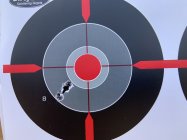I received my modified cartridge from Hornady today so I'm able to measure my Savage's headspace. I had to do it multiple times because I wasn't sure how hard to seat the case in the chamber or the bullet to the lands. The case doesn't "click" against the shoulder of the chamber, its more like the shoulders just starts squeezing the case. Same for the bullet.
My first attempt yielded 2..272 as did my second. I figured if my third attempt was the same, it would be an accurate measurement and I was done. The next one was 2.264 and the four subsequent attempts were above and below that up to .004. I finally hit on 2.260/1 several times in a row and I'm bottoming out the case against the shoulders without cramming it in there, and the bullet is on the lands with just enough pressure that it requires a good rap on the butt of the gun to get it out. I'm going to attempt this again tomorrow until I'm confident this is a repeatable number.
With a CBTO of 2.260, the COAL is 2.887 with a Hornady ELD Match 140 grain bullet. The maximum COAL for that round is listed as 2.800. Even allowing some space for backing off the lands, this is still going to be a long bullet. As I understand the effects of loading long, velocity, and possibly accuracy, are going to suffer at normal loads because there is extra empty space in the case. A cartridge this long won't fit in my AICS 10 round magazine, but I've heard a 5 round magazine will take a bullet up to 2.900 so that is an option. Is there anything else to consider before I start working up loads with these measurements (assuming the CBTO really is 2.260)?
My first attempt yielded 2..272 as did my second. I figured if my third attempt was the same, it would be an accurate measurement and I was done. The next one was 2.264 and the four subsequent attempts were above and below that up to .004. I finally hit on 2.260/1 several times in a row and I'm bottoming out the case against the shoulders without cramming it in there, and the bullet is on the lands with just enough pressure that it requires a good rap on the butt of the gun to get it out. I'm going to attempt this again tomorrow until I'm confident this is a repeatable number.
With a CBTO of 2.260, the COAL is 2.887 with a Hornady ELD Match 140 grain bullet. The maximum COAL for that round is listed as 2.800. Even allowing some space for backing off the lands, this is still going to be a long bullet. As I understand the effects of loading long, velocity, and possibly accuracy, are going to suffer at normal loads because there is extra empty space in the case. A cartridge this long won't fit in my AICS 10 round magazine, but I've heard a 5 round magazine will take a bullet up to 2.900 so that is an option. Is there anything else to consider before I start working up loads with these measurements (assuming the CBTO really is 2.260)?











